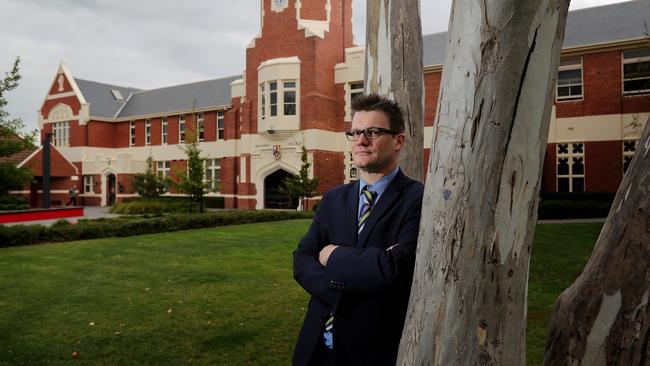Going by the evidence: Ballarat Clarendon College’s Greg Ashman
Ballarat Clarendon College’s Greg Ashman is on a mission to ensure high-quality evidence informs teaching practice.

To his Victorian Certificate of Education students, Greg Ashman is the straight-talking head mathematics teacher who keeps them on the straight and narrow.
To his colleagues, however, he’s the guy known to “bombard” their email inboxes with links to interesting articles and papers about evidence in the education space that he has come across.
“I have calmed down over time,” Ashman jokes.
His passion for sorting out the facts from the hype when it comes to the most effective way to teach a classroom of young people has been brewing for years and recently saw him elevated to the role of head of research at Ballarat Clarendon College in regional Victoria. The role, which comes secondary to his teaching job, involves vetting the latest research to come out of universities and institutes to ensure the practices employed by the school are based on high-quality evidence.
“This may sound as if it should be obvious and normal, but I had worked so many years in the UK and very little reference was made to evidence when making decisions,” he says. “At Clarendon … when anyone suggests a course of action the first question is to ask what evidence there is that is relevant to that suggestions. We are still highly innovative but we avoid a few blind alleys.”
It’s a policy that has worked for the college, which has been identified as one of the top-performing regional and coeducation schools in the country. Last year 44 per cent of its Year 12 students received an Australian Tertiary Admission Rank above 90.
Research in education has been in the spotlight in recent months, coinciding with a federal government review set up to examine the evidence on how to improve student achievement and school performance.
The panel, chaired by businessman David Gonski, recently came out with a swag of recommendations, including the establishment of a national evidence institution to equip teachers to make evidence-informed choices that hopefully would lift Australia out of the rut in which literacy and numeracy standards have declined during the past 20 years.
While Ashman says there is some internationally regarded research going on in Australia already, singling out the University of NSW, where he is studying his PhD, it is not enough and is typically sociological rather than scientific in nature.
He says the situation could be improved significantly if researchers were to replicate the way medical trials were conducted — independently, randomised and with a control group — pointing to the work of the recently established social venture Evidence for Learning, which is working on several large rigorous trials.
While such studies tend to be expensive, smaller trials that focus on assessing small changes to teaching approaches or methods also may add insight into better ways of teaching, Ashman says.
“This is how cognitive load theory developed,” he says, referring to UNSW professor John Sweller’s research into how the brain learns and retains information. Sweller has argued that explicit instruction can prevent students’ attention from being overloaded with information, ensuring that key ideas are transferred to long-term memory for later use.
“For example, studying a worked example of a maths problem allows students to focus on the key elements to be learned,” Ashman says. “Prior knowledge can also help prevent a student becoming overloaded. If a student simply knows that seven times eight is 56 then she doesn’t have to waste precious attention working this out and can instead focus on other aspects of a maths problem.”
Ashman’s views diverge from some theories of education that have led to the elevation of so-called 21st-century skills, such as critical and creative thinking, within the curriculum. The push also has led to the increasing popularity of inquiry or project-based learning, where students are expected to figure out some or all of the learning themselves. Ashman believes it to be largely ineffective as a teaching method because it overloads a novice learner with too much to think about.
“Pretty much all evidence points to an inescapable fact about learning: when you are teaching new academic concepts to students who have not encountered them before, you need to break them down into small steps and teach them directly and explicitly,” he says. “Unfortunately this is not sexy. The world is abuzz with teaching methods that follow precisely the following approach.”
Ashman, who has been in the profession for more than 20 years, has published a book, The Truth About Teaching, which is aimed at beginner teachers and deals with issues they are likely to encounter. It was inspired by what he would have liked to have known when he was starting out, and he hopes it will help readers avoid common mistakes and will challenge myths about good teaching.
He says it has attracted interest from non-teachers, including parents, who “simply want a better understanding of what is happening in our schools”.
“Some schools are still in the habit of jumping on fashionable fads because they seem ‘truthy’ or they play to an ideal of how they would prefer the world to be,” he says. “A fad is something that someone will metaphorically or literally try to sell you. When you ask for evidence of effectiveness, they will be offended or they will reply with something vague.”


